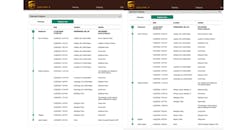While we are spending lots of time thinking about and trying to innovate delivery over the last mile, what about all the rest of the delivery? I ordered two Apple watches in November, with the hopes they would arrive before we left for a short vacation in Branson, MO, where we meet up with my older brother and sister-in-law each year. It was fascinating and enlightening to watch how these two very small packages moved from origination to destination.
Below are pictures of the two watches travels, side by side, as registered by UPS. Some interesting observations:
- They were ordered online from the Apple Store at the same time. I recall it was late on Friday night, Nov. 2.
- I received notification that the AppleCare Proof of Coverage was approved that same evening and would extend for one year from Monday, Nov. 4.
- One phone shipping label was created in China on Nov. 2 while the other was created on Nov. 5, three days later. Maybe the gold colored watch with a gold band took longer to manufacture than the silver one with a black band?
- One watch went to Korea, while the other did not. Both flew to Anchorage, AK, then to Louisville, KY, then back to Portland, OR. Hub and spoke distribution system at its best.
- The watches arrived within one day of each other, one on Nov. 8, and the other on the Nov. 9, in spite of being shipped 3 days apart.
Now, let’s look at a different scenario and a different carrier. I ordered some trade show booth materials on the morning of Dec. 26. It was too heavy and too big to fit into a single box, so they put it into two boxes.
- They were shipped by ground the same day and picked up at 2:40 p.m.
- They arrived at FedEx three hours apart and one shipping label had to be replaced.
- They departed at the same time, probably on the same trailer, the next morning, Dec. 27.
- They both arrived in Troutdale, OR, on Dec. 30 after traveling 3,042 miles in 3 days (72-74 hours). That’s a 42.25 mph rate, including stops. Assuming 11 hours of driving time for 3 days, 33 hours, that would be an impossible 92 MPH. Therefore, I must assume this was a relay with multiple drivers involved.
- I thought the packages might be delivered on New Year’s Eve. My local UPS store indicated they had only seen express deliveries, not ground deliveries that day. So, the package sat for a couple of days.
Here are some thoughts from this experience to consider:
- The last mile delivery is not the only place where there are still opportunities for improvement.
- Shipping labels can get messed up. What can be done to avoid that and any delays it might cause?
- Tracking items from origination to destination is not only valuable but expected today.
- Packages don’t always go direct from origination to destination. What can be done to minimize the out-of-route miles?
- Delays occur. What can be done to eliminate or minimize them?
- With the increase in purchasing online, our shipping systems are being stressed.
- In spite of that, I don’t recall hearing too many complaints that Christmas presents did not arrive on time this year.
- We work in an amazing industry that keeps everything moving and everyone happy most of the time.
My next post will provide some ideas for improvement gleaned from the CES press events of some of the trucking OEMs.
About the Author
Paul Menig
CEO
Paul Menig is the CEO of Business Accelerants, a consulting company focused on helping companies succeed by leveraging technology in their products and processes.


